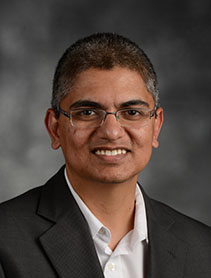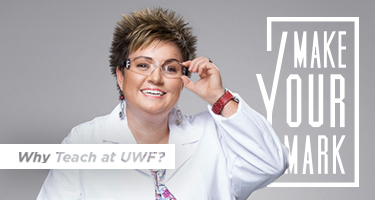
Dr. Tanay Kesharwani
- Position: Professor
- Department: Chemistry
- Office Location: Building 58C, Room 204H
- tkesharwani@uwf.edu
- Campus: 850.474.2743
Biography
Dr. Tanay Kesharwani, a Professor in the Department of Chemistry, focuses his research on developing new synthetic methods that can be used on novel materials and small molecules. Kesharwani earned a Ph.D. in Organic Chemistry from Iowa State University, where his dissertation examined aspects of electrophilic cyclization, palladium migration, and cationic polymerization. While at Iowa State he won a Teaching Excellence Award.
He had two postdoctoral fellowships – first in the Department of Drug Development at NewLinks Genetics in Ames, Iowa, and then in the Department of Chemistry at Northwestern University. At UWF, Kesharwani’s research examines such topics as the development of Pd catalyzed C-H activation reactions; methodology development and synthesis of biologically interesting heterocycles; new techniques for the solid and liquid phase “combinatorial chemistry;” and design and synthesis of porous materials for gas storage and catalysis applications. One current project looks at environmentally benign electrophilic chlorocyclization reactions.
He shares several patents with colleagues and is an active referee for several academic journals. Kesharwani’s research has been published in numerous publications, including Tetrahedron Letters, Journal of Organic Chemistry, and Polymer Chemistry. Kesharwani taught Chemistry at Bard College in New York before joining UWF in 2013. He has a B.S./M.S. (Integrated) in Chemistry from Indian Institute of Technology in Bombay.
Degrees & Institutions
Postdoctoral Fellow Northwestern University (2010-2011)
Postdoctoral Fellow NewLink Genetics (2008-2010)
Ph.D., Iowa State University (2002-2008)
M.S., Indian Institute of Technology Bombay (1997-2002)
B.S., Indian Institute of Technology Bombay (1997-2002)
Research
Dr. Kesharwani's research at UWF focuses on developing new synthetic methods that can be used on novel materials and small molecules. He examine topics such as development of Pd catalyzed C-H activation reactions; methodology development and synthesis of biologically interesting heterocycles; new techniques for solid and liquid phase “combinatorial chemistry;” and design and synthesis of porous materials for gas storage and catalysis applications. One current project looks at environmentally benign electrophilic chlorocyclization reactions.
Current Courses
- Organic Chemistry I
- Organic Chemistry I Lab
- Advanced Lab Techniques
Classes Taught
- Organic Chemistry I, II and Labs
- Special Topics in Advanced Chemistry
- Seminars in Chemistry
- Directed Study
- Undergraduate Chemistry Research
Special Interests
Publications
Chen, X. Y.; Kesharwani, T.; Wu, Y.; Stern, C. L.; Đorđević, L.; Wu, H.; Yu Wang, Feng, F.; Zhang, L.; Zhao, X.; Jiao, Y.; Li, X.; Han. H.; Tang, C.; Zhang, R.; Chen, H.; Cai, K.; Stupp, S. I.; Chen, H.; Shen, S.; Stoddart, J. F. “Site-Selective C–H Functionalization in a Cyclodextrin Metal-Organic Framework” Chem, 2024, 10, 234-249.
David, A. H. G.; Garci, A.; Abid, S.; Li, X.; Young, R. M.; Seale, J. S. W.; Hornick, J. E.; Azad, C. S.; Jiao, Y.; Roy, I.; Akpinar, I.; Kesharwani, T.; Stern, C. L.; Wasielewski, M. R.; Stoddart, J. F. “Divinylanthracene-Containing Tetracationic Organic Cyclophane with Near-Infrared Photoluminescence” J. Am. Chem. Soc. 2023, 145 (16), 9182–9190.
Khan, N.A.; Azad, C.S.; Luo, M.; Chen, J.; Kesharwani, T.; Badshah, A.; Wang, D. “Mechanistic Approach towards Designing Covalent Organic Frameworks for Photocatalytic Hydrogen Generation” Energies 2023, 16, 5888.
Zahra A.; Albertson, A.; Walter. C; Masih, P.; Kesharwani, T. “Synthesis of Benzo[b]thiophenes via Electrophilic Sulfur Mediated Cyclization of Alkynylthioanisoles” J. Org. Chem. 2022, 87, 6312-6320.
Masih, P. J.; Kesharwani, T.; Rodriguez, E.; Vertudez, M. A.; Motakhaveri, M. L.; Le, T. K.; Tran, M. K. T.; Cloyd, M. R.; Kornman, C. T.; Phillips, A. M. “Synthesis and Evaluation of 3- Halobenzo[b]thiophenes as Potential Antibacterial and Antifungal Agents” Pharmaceuticals 2022, 15, 39.
Auld, N.; Flood, K.; Kesharwani, T.; Cavnar, P. “A study on the cellular and cytotoxic effects of S and Se heterocycles on the myeloid leukemia cell line PLB-985” Phosphorus Sulfur Silicon Relat. Elem. 2022, 197 (8), 876–884.
Cunningham, C. M.; Cloyd. M; Phillips, A.; Khan; S.; Whalen K. E.; Kesharwani, T. “A one- pot successive cyclization–alkylation strategy for the synthesis of 2,3-disubstituted benzo[b]thiophenes” to be submitted in Org. Biomol. Chem. 2021, 19, 4107-4117.
Huggins. M.*; Kesharwani, T.; Buttrick, J.; Nicholson. C. “A Variable Temperature NMR Experiment Studying Restricted Bond Rotation” J. Chem. Ed. 2020, 97, 1425-1429. Philips, A.; Cunningham, C.; Naran, K.; Kesharwani, T. Synthesis of 3-Halo-7-Azaindoles through a 5-Endo-Dig Electrophilic Cyclization Reaction. Synlett 2019, 30 (10), 1246–1252.
Kumar, S.; Waldo, J.; Jaipuri, F.; Marcinowicz, A.; Van Allen, C; Adams, J.; Kesharwani, T.; Zhang, X.; Metz, R.; Oh, A.; Harris, S. F.; Mautino, M.* “The Discovery of Clinical Candidate
(1R,4r)-4-((R)-2-((S)-6- fluoro-5H-imidazo[5,1-a]isoindol-5-yl)-1- hydroxyethyl)cyclohexan-1- ol (Navoximod), a Potent and Selective Inhibitor of Indoleamine 2,3-dioxygenase 1” J. Med. Chem. 2019, 62, 6705-6733.
Walter, C.; Fallows, N.; Kesharwani, T. Copper-Catalyzed Electrophilic Chlorocyclization Reaction Using Sodium Chloride as the Source of Electrophilic Chlorine. ACS Omega 2019, 4 (4), 6538–6545.
Bokoskie, T.; Cunningham, C.; Kornman, C.; Kesharwani, T.; Pattabiraman, M. Iodocyclization in Aqueous Media and Supramolecular Reaction Control Using Water- Soluble Hosts. ACS Omega 2019, 4 (18), 17830–17836.
Kesharwani, T.; Kornman, C.; Tonnaer, A.; Hayes, A.; Kim, S.; Dahal, N.; Romero, R.; Royappa, A. Sodium Halides as the Source of Electrophilic Halogens in Green Synthesis of 3-Halo- and 3,n-Dihalobenzo[b]Thiophenes. Tetrahedron 2018, 74, 2973–2984.
Kesharwani, T.; Giraudy, K. A.; Morgan, J. L.; Kornman, C.; Olaitan, A. D. Green Synthesis of Halogenated Thiophenes, Selenophenes and Benzo[b]Selenophenes Using Sodium Halides as a Source of Electrophilic Halogens. Tetrahedron Letters 2017, 58 (7), 638–641.
Keywords: Pd catalyzed C-H activation reactions, biologically interesting heterocycles, solid and liquid phase combinatorial chemistry, design and synthesis of porous materials, electrophilic cyclization, palladium migration, cationic polymerization, environmentally benign electrophilic chlorocyclization reactions



